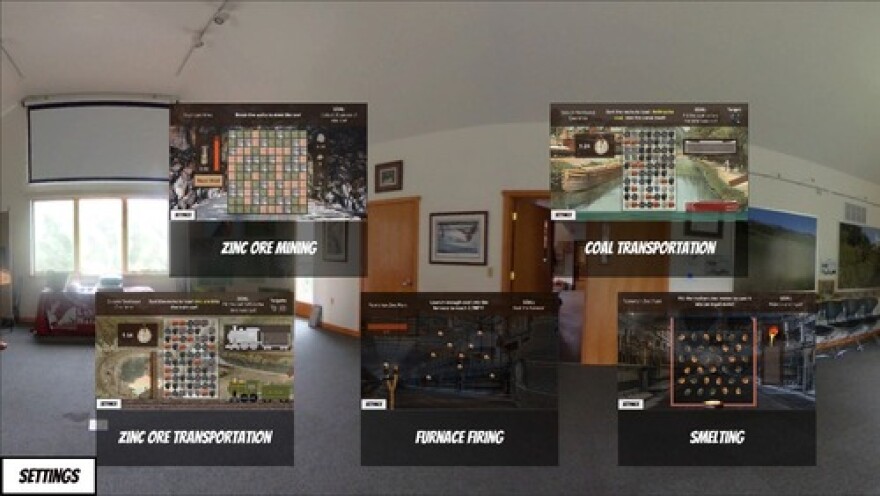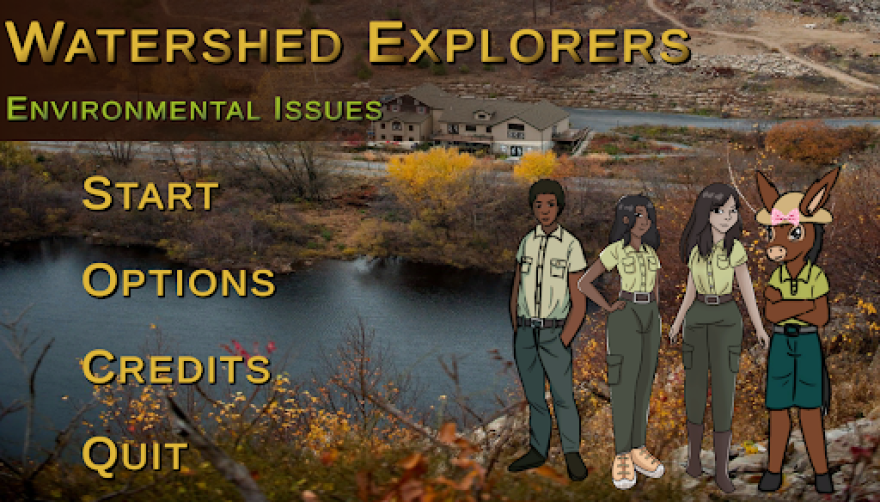BETHLEHEM, Pa. — Immersive learning experiences through Lehigh University lets students and visitors hike Lehigh Gap or kayak down the Lehigh River — without actually stepping foot outside.
“I want people outside experiencing nature,” Alec M. Bodzin, a professor in Lehigh’s Teaching, Learning and Technology program, said.
“Not everybody — not every kid — wants to do that. So this is a way to get kids engaged and curious and motivated to want to learn and go out into nature.”
“And then hopefully, we will be able to engage more and more people, and they will know why the Lehigh River is called the Lehigh River, and why the Lehigh Valley is called the Lehigh Valley, and so on.”Robson M. Araujo-Junior, assistant professor of Learning Technologies at Kutztown University
Lehigh now has six immersive learning experiences, or virtual reality games, aimed at engaging students, residents and visitors to promote local environmental literacy.
Designed to be played either through desktop or headset, the games can be used by players to discover how the landscape of the Valley has changed over time, explore environmental issues in the Lehigh River watershed and learn about flood preparedness and safety.
Games include: "The Lehigh Gap Story," "Watershed Explorers," "Flood Adventure" and "Mystery of the Lehigh Gap."
In addition to the full Watershed Explorers game, there are two shorter versions based on themes, "Watershed Explorers: Industrial History" and "Watershed Explorers: Environmental Issues."
“By doing these games, we can preserve the local history and heritage by making not only those visuals and photos to live forever in the digital medium — like with the virtual reality, with the video games in the computer — but we also are bringing and shorten the gap between the local knowledge the indigenous knowledge,” Robson M. Araujo-Junior, whose doctoral dissertation at Lehigh focused on Watershed Explorers, said.
“And then hopefully, we will be able to engage more and more people, and they will know why the Lehigh River is called the Lehigh River, and why the Lehigh Valley is called the Lehigh Valley, and so on.”
‘We got something here’
Back in 2018, Bodzin was working with a group of Allentown students, equipped with tablets, collecting data on urban heat islands.
Out in the field, students were interested and engaged, he said. When they got back to the classroom, it was a different story.
“Half of them are watching videos of people playing video games instead of doing analysis,” Bodzin said.
He came up with an idea — a game-based learning activity, complete with a headset. The students were on board, so he quickly created a prototype, letting students virtually fly over the landscape.
“It was like May and June, when kids are usually checked out of school, and we had the most high engagement of these kids I've ever seen in my life,” he said.
“I've never seen kids so immersed and engaged. I thought to myself, ‘Wow, we got something here that's really a possibility.’ Unfortunately, then, the pandemic hit.”
The COVID-19 pandemic shuttered schools in the Valley and across the country.
But traditional classrooms proved not to be the best fit for the games, anyway, Bodzin said.
“I don't think most schools in the United States are equipped to do this right now,” he said. “Places in South Korea are going full throttle with this. Singapore is going full throttle with this.
"There's American schools overseas that are doing this stuff, but in the United States, it's just not there.”
There are several reasons, he said, such as lack of space and support, as well as day-to-day upkeep, such replacing batteries and other maintenance, that one teacher with 30 students might struggle integrating headsets into the classroom.
The team, made up of professors and students, turned to nonformal education sites, such as Nurture Nature Center and the Delaware & Lehigh Heritage Corridor in Easton, Jacobsburg Environmental Education Center in Bushkill Township, and Lehigh Gap Nature Center in Slatington.
“People come to them — I thought these would be a natural thing to kind of work to incorporate these experiences with things that they already do when youth come to visit them from schools,” Bodzin said.
“And that's kind of the big vision for us, moving forward.”
‘It enhances what we do‘
It was during an annual visit with students to Lehigh Gap Nature Center several years ago that Bodzin brought up the idea for a virtual field trip.
“It sounded interesting,” Chad Schwartz, the center’s executive director, said.
“It was something that I hadn't seen before in environmental education, and I thought that it had some really interesting potential to engage new audiences.
"Maybe bring some concepts to life that we might not be able to do through traditional programs.”
In “The Lehigh Gap Story,” players learn the history of the only nature center in the United States situated on a Superfund site.
“This is a desktop virtual reality where it's basically a virtual field trip, and you have this avatar named Brownie,” Bodzin said.
“The narrative is she kind of tells a very emotional story of how her ancestors were in this area, and then the zinc plant came in and denuded the landscape.
"And then, it gets into talking about the revegetation that the Lehigh Gap Nature Center is doing.
“And so you're basically taking a virtual hike.”
‘The more we can integrate, the better‘
While acknowledging that some might express concerns about visitors favoring the virtual experience over reality, Schwartz argued the technology can act as a motivating force, too.
“It sells people on the story, and it really does bring it to life in ways that we can't necessarily, like the acid rain simulation,” Schwartz said. “We can't do that here.
“There's just so many opportunities to really communicate those concepts differently than we could without the technology — I think it enhances what we do.
"The more we can integrate that into what we do, the better I think.”
Another game, “Mystery of the Lehigh Gap,” takes players through time, learning about the history of the site.
“In between the narrative, you play these five mini-games, and they're based on things like Candy Crush and Angry Birds and Pachinko that type of thing,” Bodzin said.

The center now has eight headsets, funded through two grants.
“We have them here at the nature center now, and we plan to put them to use this year, both at our events, but also just we'll have them around when we do outreach,” Schwartz said.
“We can take them to tabling events off site, and someday we'd like to have a virtual tour of the nature center, too, that we might add to those.
"So it opens up a lot of opportunities just by having this technology now we can experiment with other things in the future.”
‘Raising awareness’
Like “The Lehigh Gap Story,” “Watershed Explorers” also is a desktop virtual reality game.
Working with Bodzin, Araujo-Junior planned a series of interconnected games and immersive experiences focused on the watershed.
A self-described game design and development expert, Araujo-Junior said he has many hours of video game-playing experience, and coupled that with his study of environmental education.
“We wanted to make sure that we were raising awareness of everything that has happened and still happens in the Lehigh River, but these topics are kind of not having much space in the traditional curriculum because there's lots of teaching for testing these days,” he said.
“And then kids, unfortunately, they don't have time to learn at school about the place where they live or where they are from.”
In the game, players kayak down the Lehigh River after they’ve been hired by the D&L to recommend three locations for promoting tourism in the watershed.

“It takes about one hour for the people to finish, and that was not our intention, because we want people to have more or less a 15 to 20 minutes experience, so they can be engaged, but they can take away something from that experience,” Araujo-Junior said.
“And if they wish, they can come back at any time and like, visit again or explore another piece of the experience, so at their own pace.”
Two shorter versions were created, focused on industrial history and environmental issues, that can be used on headsets.
For the thesis, Araujo-Junior studied the relationship between lifelong learning and technology, looking at the roles of formal, informal and nonformal education.
“The takeaway is that learning is for everyone, and can take place at any place, anywhere,” he said.
“We often have this idea that, ‘Oh, learning is schooling,’ or it should take place only in school. No, not anymore.
“We are already in 2025, it's the first fourth of the 21st century that is coming to a close, and education needs to level up, needs to adapt and change, because we already have access to almost infinite information and lots of technologies that are out there to help us, but we tend not to be aware of them.”
Araujo-Junior’s dissertation, “Watershed Explorers: Digital Gameful Learning Experience Gameplay Investigated with Immersive Virtual Reality within a Technology-Enhanced Lifelong Learning Ecology,” received the 2025 Elizabeth V. Stout Award.
Currently an assistant professor of Learning Technologies at Kutztown University, Araujo-Junior said he’s still able to carry on his work at Lehigh as a volunteer, community partner and technology consultant.
'Physically visit these places'
The most recent game, “Flood Adventure,” was released in the spring.
“It's a game-based simulation,” Bodzin said. “And you're in a house, and a flood warning goes off, and you have three minutes to pick up everything in the house and get it into your car and get out.”
Depending on what they picked, players get a star rating.
“Then you find out it's a dream, and then you get walked through a process of putting together a flood preparedness kit, and you leave it in the garage by your car, and then the alarm goes off," he said.
“And this time, you've got your flood preparedness kit ready.”
It’s only available on desktop, but should be available on headsets in a year or so, he said.
While it might seem counter-intuitive, the immersive games have worked to get players more interested in exploring the actual environment, officials said.
After piloting “Watershed Explorers,” researchers asked participants to complete a survey, including a very important question — “Would you be interested in visiting these places that you saw in the experience?”
“Almost everybody said yes, and that's what we want,” Bodzin said.
“And so we see this as a way to get people to learn about places in an engaging and immersive way, and then they'll want to go out and go do these things outside, or physically visit these places.
"And that's a big goal for us in doing this.”


